Two terms define the future of our production model: digitalization and sustainability. And the two terms are more closely related than they may seem.
A global and burgeoning process such as digitalization must be sustainable; in other words, its deployment and development must not compromise the ability of future generations to meet their own needs. This is what we mean when we talk about sustainability.
As with other sectors or areas of knowledge, digital transformation must be approached in an environmentally friendly way. This is something relatively new, as for a long time the focus has been on digitalization itself, somehow forgetting its implications at different levels; also in the field of ecology, at least on the part of the general public.
Thus, until recently, when we talked about concepts such as the cloud, where the storage of information takes place in a location that is diffuse or even unknown to the user, it was not common to consider the costs or the environmental impact they caused.
However, it is easier to understand these concepts when we store information on a device we own: even if we do not analyse it in detail, it is easy to understand that it involves an energy cost, materials used for its assembly, an outlay for its acquisition and maintenance, etc. In short, it is clear to understand its ecological footprint.
This environmental cost can become alarming as more and more people use these types of services. And that is precisely what digital sustainability seeks to avoid. Now digitalization and sustainability go hand in hand, they are “twins”.
AI, cloud computing and the internet of things as enabling the speed and scale needed to achieve the EU’s decarbonization targets
The European Commission defines the twin transition as harnessing the potential of the digital transformation as a key factor in achieving the targets of the European Green Deal. In other words, not only is it necessary to drive a digital transformation that is sustainable, but digitalization itself is key to achieving sustainability.
Also the Fit for 55 package, which calls for a 55% reduction in carbon emissions by 2030, sees AI, cloud computing and the internet of things as enabling the speed and scale needed to achieve the EU’s decarbonization targets.
Moreover, the new Industrial Strategy for Europe stresses that the twin, ecological and digital transition will affect every part of our economy, society and industry; and it highlights the prominent role of the energy sector.

The role of twin transformers organizations
As with any major change, this cannot take place without the participation of society as a whole. In this regard, organizations have a leading role to play in driving sustainable digital transformation.
According to Accenture, the functions of twin transformer organizations include, inter alia, the search for business models based on sustainability and driven by technology; fostering a sense of responsibility throughout the organization – with KPIs that go beyond financial results, such as emissions reduction or resources obtained through sustainable sources. And also, alignment with its partners to achieve sustainable life cycles and improve traceability.
The energy sector is fully digitized and uses technological advances to reinforce service to society and ensure sustainability
Technology-driven sustainability not only has a positive impact on society and the environment, but is also a good indicator for improving stakeholder relations, customer loyalty, new business opportunities, competitive improvement, regulatory compliance and fostering innovation.
The energy sector is a good example of this: a fully digitalized sector that uses technological advances to strengthen the service to society and ensure sustainability.